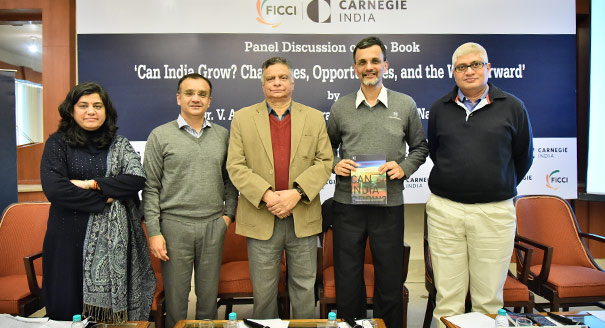Registration
You will receive an email confirming your registration.
Despite India’s impressive growth rates in the mid-2000s, its subsequent stagnation reflects both the unfavorable global environment and India’s own structural and capacity deficiencies. While there are some favorable tailwinds, sustaining a feasible growth rate requires that India focus on the economic fundamentals behind such growth and resist the temptation of pursuing short-term high-growth strategies.
Carnegie India hosted the launch of Dr. V Anantha Nageswaran and Gulzar Natarajan’s new report “Can India Grow? Challenges, Opportunities and the Way Forward”. This was followed by a discussion on India’s growth prospects with V Anantha Nageswaran, journalist TCA Srinivas Raghavan, and Siddharth Singh, editor-at-large at Open Magazine. The conversation was moderated by Shivnath Thukral, managing director at Carnegie India.
DISCUSSION HIGHLIGHTS
- Institutional Problems: Discussants pointed out that as a result of its colonial legacy, the Indian state views itself as “the boss.” This leads to rampant corruption and inefficiency and hampers the proper functioning of the three arms of the state. Discussants argued that the legislature, instead of acting as an agent of change, often acts as a roadblock.
- Understatement of Growth: Participants added that institutional deficiencies have led to the official understatement of real output and growth, since the onset of economic liberalization, due to inefficiencies in the government’s statistical machinery.
- Fragmentation of Landholdings: Speakers recognized that amending the Hindu Succession Act of 1956 to prevent continued fragmentation of land-holdings was a precondition for reforming the agricultural sector. Participants discussed the fact that without much-needed reforms, it is not possible for India to become self-sufficient in food grains and cereals even as incomes from increasingly fragmented holdings continue to decline.
- Missing the Manufacturing Bus: Discussants highlighted the risks associated with bypassing mass industrialization in favor of mass digitalization with emphasis on the services sector. They pointed out that whether with entrepreneurial opportunities or job creation, it is only possible to achieve significant growth through manufacturing.
- Creating Work: While the focus on employment generation emerged as the Keynesian response aimed at balancing incomes over time, it has outlived its utility, participants said. A discussant emphasized the need to focus on creating opportunities for work. Participants suggested that a helpful intervention would be for the tax policy to make it easier for people to move to a self-employed (non-salaried) status. They pointed out that the formal sector’s labor supply curve would become more flexible as more work is generated. However, discussants acknowledged that the question of the level of compensation remains.
- Growth Numbers: A discussant drew parallels between the talk of India’s ‘new normal’ growth, and the idea of the ‘new mediocre’ facing the world economy. Participants emphasized that growth of 5 percent or more is sufficient, and the focus should be on solving development issues. Along similar lines, discussants also highlighted the idea that while the quantum of output being generated within India is an important consideration, the composition and quality of said output deserves greater attention. Participants also cautioned that India’s economic targets need to be set with an eye towards the global context as well as a realistic understanding of existing bottlenecks.
- Policy Experiments: The discussion focused on whether it makes sense to engineer a crisis to drive reforms through disruptive policies. Speakers discussed the possibility that demonetization may remove the stumbling blocks that constrain economic growth. They also emphasized the need to balance the message of demonetization with something more aspirational; while demonetization appeared to raise the costs of dishonesty, the rewards of honesty also need to be increased, they said.
This summary was prepared by Sharanya Rajiv, an intern at Carnegie India.
V. Anantha Nageswaran
V. Anantha Nageswaran teaches courses on international economics, exchange rates, and financial markets to graduate students at the Singapore Management University and at the Indian Institutes of Management in Bangalore and Indore in India.
TCA Srinivasa Raghavan
TCA Srinivasa Raghavan is a journalist. He has been writing on economic and political issues for the last thirty-seven years.
Siddharth Singh
Siddharth Singh is the editor-at-large at Open Magazine.
Shivnath Thukral
Shivnath Thukral is managing director of Carnegie India.
